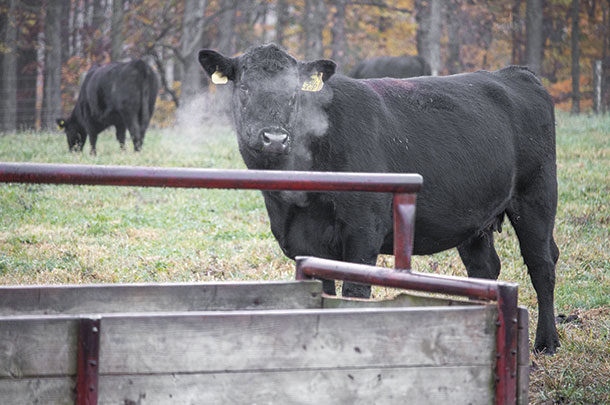This time of year also brings a slew of phone calls and emails to consultants and nutritionists concerning preconditioning nutrition and management – and rightly so, considering well more than a year’s work has gone into this calf crop. Management from here until sale time is paramount to optimizing profitability from the calf herd – but what about the other half of the equation?
Financial Investment
Upon weaning a calf, your operation’s financial investment splits from one entity into two: the weaned calf going to sale and the dry cow going to pasture for the winter, where she’s hardly given a thought until 30 to 45 days prior to calving time.
We know what we can do to protect our profitability and investment in a weaned calf: reduce stress, boost the immune system, provide adequate protein and energy for growth, a high-quality forage source and clean water. But when does development of a strong, healthy calf begin? Furthermore, what can we do to protect our profitability and investment in the calf in utero?
Nutrition
Historically, when it comes to beef cow nutrition, the priority has been to provide the most cost-effective diet possible to reduce input costs, while also providing enough nutrients to avoid reproductive failure. Body condition score (BCS) at breeding is a common indicator of her likeliness to effectively conceive. However, cow nutrition can impact far more than just conception rates, and BCS is just as important during winter months as it is come April or May because some pretty important things are happening during those late fall and early winter months.
Fetal programming
Fetal programming is the concept that a maternal stimulus or insult at a critical period in fetal development has long-term effects on the offspring. The bulk of fetal growth (75%) will occur during the final two months of gestation, meaning fetal nutrient requirements are relatively low during the first part of gestation. However, this does not mean cow nutrition during the first several months of gestation does not still affect calf growth or performance. This does mean even small, frugal changes in nutrient management can be effective.
Processes such as placental growth, differentiation and vascularization occur during the early stages of fetal development. Following those processes are the development and formation of organs; systems such as digestive, immune, reproductive and muscle; and adipose tissue. Each has its own window of time for development; you can think of it as creating the blueprints for next year’s calf crop. Essentially, when you’re maintaining a dry cow with adequate forage and supplementing as necessary, you’re programming next year’s calf to grow, perform and thrive.
Three components
There are really only three components to any beef cow: genetics, environment and management. Environment is largely out of your hands, and while genetics are getting better all the time, management will trump genetics every time. By giving a dry cow more thought this year and being more intentional in creating a blueprint, you’re giving those genetics a chance to express themselves and perform.
According to the NRC, a 1,200-pound cow seven months post-calving (consider a March calving date) requires 45% total digestible nutrients (TDN) and 6% crude protein (CP) of total diet, on a dry matter basis. This is relatively low but steadily increases each month up until calving. By mid- to late December, her requirements will be pushing 50% TDN and 7% CP. I encourage you to have your pasture forage (and/or hay) tested for quality to give yourself a baseline; then intentionally supplement to meet your dry cows’ needs this winter in order to both be more cost effective and to set yourself up next year for a strong, healthy calf crop which has been programmed to perform. ![]()
PHOTO: Nutritional decisions at this time of year could dictate profitability outcomes for the dam months and years from now. Photo by Cassidy Woolsey.

-
Caitlin Hebbert
- Noble Research Institute
- Livestock Consultant
- Email Caitlin Hebbert









